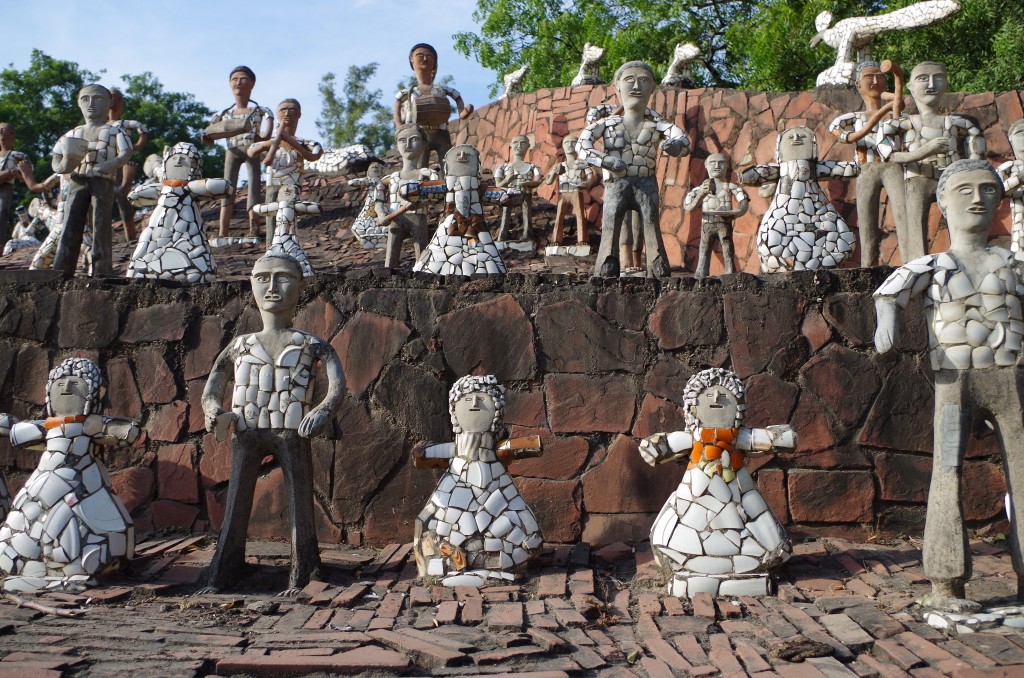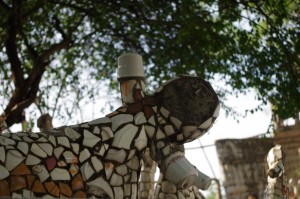Chandigarh, the capital of the Indian Punjab, was seen as a ground-breaking experiment in town planning when it was commissioned following Indian Independence in 1947. Designed by Swiss-French architect Le Corbusier, the city’s orderly grid of boulevards combined with extensive stretches of green were felt to represent a new India which was ready to embrace the country’s independent future. But it was one man’s project of passion secretly constructed on the edges of this rigidly planned city which would eventually become the main reason thousands of visitors would flock to Chandigarh.
During Chandigarh’s construction, Nek Chand was employed as a road inspector with the Public Works Department (PWD) and around 1958, as a hobby, started secretly constructing his own fantasy world using waste material on a patch of wasteland just outside the city’s main administrative district. Undiscovered for years, Chand worked under the cover of darkness in harsh conditions:
“To protect myself from the clouds of mosquitoes at night I would have to cover my head and body wit gunny bags. When I wanted to return home I would hold a flaming tyre in my hand because there were plenty of snakes in the jungle.” (*see footnote)
Having only ever disclosed his work to his wife and a few trusted friends, when the authorities discovered Chand’s work in 1975, instead of demolishing this illegal constru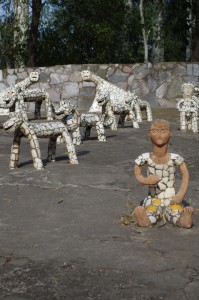 ction they gave Chand permission to continue, naming the site ‘Rock Garden’ and assigning him a work force to continue his construction.
ction they gave Chand permission to continue, naming the site ‘Rock Garden’ and assigning him a work force to continue his construction.
Today, Chand’s Rock Garden is a government-sponsored tourist site and claims to be India’s second most popular tourist attraction after the Taj Mahal. To enter, you need to stoop under a low arch in the opposing perimeter wall from which a number of mosaic cranes observe your every move as you enter Chand’s maze of winding pathways which he constructed using no formal plan, just the natural undulations of the landscape as a guide. Walking this maze of decorative pathways visitors can discover 40ft waterfalls which emerge from concrete forts, elaborate arches decorated with old electrical parts and brightly mosaicked outdoor theatres constructed over rivers.
As visitors move through to third phase, they are lead through a manmade gorge, the walls of which have been constructed using sacking and cement which bulge as though about to give way at any moment. Despite this dramatic entrance, the third phase feels a little disappointing and more like a Nek Chand theme park complete with an aquarium, food stalls and camel rides. More mass production construction than organically grown creation.
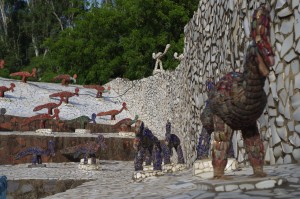 The real delight of the Rock Garden can be found in its second phase where human and animal characters group together to form the garden’s sculpture collection. Having created a walkway with carefully mosaicked raised platforms on either side, you feel you are wandering through a series of stage sets on which a varied cast of creatures and people rehearse for their next performance. As you saunter past broken bangle peacocks, men with teacup hands and bears with clinker fur, the mind boggles to devise what the story is these unique and wonderful characters are trying to communicate.
The real delight of the Rock Garden can be found in its second phase where human and animal characters group together to form the garden’s sculpture collection. Having created a walkway with carefully mosaicked raised platforms on either side, you feel you are wandering through a series of stage sets on which a varied cast of creatures and people rehearse for their next performance. As you saunter past broken bangle peacocks, men with teacup hands and bears with clinker fur, the mind boggles to devise what the story is these unique and wonderful characters are trying to communicate.
A place which often evokes passion in those who tread its meandering paths, it was a delight to discover that Professor Iain Jackson of the University of Liverpool had previously extensively researched and catalogued the works within Nek Chand’s Rock Garden, explaining:
“I found Nek Chand’s story so intriguing, but it was the scale of the garden, the waterfalls and armies of humorous sculptures that really seduced me. I liked the way Nek Chand gathered the remains of the demolished villages, and used those discarded fragments of everyday life to create something beautiful. He takes the unwanted, forgotten and worthless and transforms it into a playful journey, a promenade of unexpected drama.”
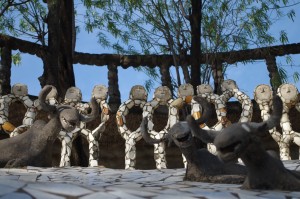 Jackson’s passionate study culminated in an exhibition of his research and Chand’s sculptures at Liverpool’s RIBA Gallery back in 2007. Making a concerted effort to evoke a sense of physically being in the Rock Garden through the exhibition experience, Jackson found the individuality of Chand’s work translated well to a UK audience.
Jackson’s passionate study culminated in an exhibition of his research and Chand’s sculptures at Liverpool’s RIBA Gallery back in 2007. Making a concerted effort to evoke a sense of physically being in the Rock Garden through the exhibition experience, Jackson found the individuality of Chand’s work translated well to a UK audience.
Nek Chand’s Rock Garden is a unique world of possibilities which has brought pleasure to the hundreds of thousands of visitors who have wandered its pathways discovering hidden spaces and delightful characters. A true project of passion, the feeling that one man poured every extra scrap of his energy into making this space a reality can be found in each part of the garden’s detail. Now an internationally recognised and respected artistic endeavour by one of India’s greatest living artists, the Rock Garden will no doubt attract and enchant visitors for years to come.
*Quote – sourced from A Visit with the Master: The Creative Genius of Nek Chand in the essay Nek Chand Shows the Way by Philip Reeve, originally published in Raw Vision #9.

